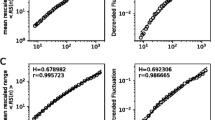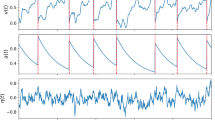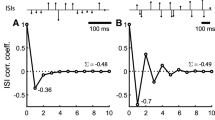Abstract
We study the spike statistics of an adaptive exponential integrate-and-fire neuron stimulated by white Gaussian current noise. We derive analytical approximations for the coefficient of variation and the serial correlation coefficient of the interspike interval assuming that the neuron operates in the mean-driven tonic firing regime and that the stochastic input is weak. Our result for the serial correlation coefficient has the form of a geometric sequence and is confirmed by the comparison to numerical simulations. The theory predicts various patterns of interval correlations (positive or negative at lag one, monotonically decreasing or oscillating) depending on the strength of the spike-triggered and subthreshold components of the adaptation current. In particular, for pure subthreshold adaptation we find strong positive ISI correlations that are usually ascribed to positive correlations in the input current. Our results i) provide an alternative explanation for interspike-interval correlations observed in vivo, ii) may be useful in fitting point neuron models to experimental data, and iii) may be instrumental in exploring the role of adaptation currents for signal detection and signal transmission in single neurons.







Similar content being viewed by others
Notes
In this case, the unstable subthreshold limit cycle still exists, while the unstable spike-associated limit cycle involving the voltage reset has become unstable itself. Perturbations around the spike limit cycle will grow in an oscillatory manner, can then overcome the inner unstable limit cycle due to the reset rule and go eventually to the stable focus.
Choosing a very small noise intensity for all parameters entails other difficulties: if the jitter of the interspike interval (order of C V⋅T ∗) becomes very small (of the order of the discrete time step Δt), numerical errors in the simulation results due to the discrete nature of our integration scheme can be expected. These errors can be reduced by decreasing the time step, which may become computationally expensive.
References
Avila-Akerberg, O., & Chacron, M.J. (2011). Nonrenewal spike train statistics: causes and consequences on neural coding. Experimental Brain Research, 210, 353.
Bear, M.F., Connors, B.W., & Paradiso, M.A. (2007). Neuroscience: Exploring the brain. Baltimore: Lippincott Williams and Wilkins.
Benda, J., & Herz, A.V.M. (2003). A universal model for spike-frequency adaptation. Neural Computation, 15, 2523.
Benda, J., Longtin, A., & Maler, L. (2005). Spike-frequency adaptation separates transient communication signals from background oscillations. Journal of Neuroscience, 25(9), 2312.
Benda, J., Maler, L., & Longtin, A. (2010). Linear versus nonlinear signal transmission in neuron models with adaptation currents or dynamic thresholds. Journal of Neurophysiology, 104(5), 2806.
Brette, R., & Gerstner, W. (2005). Adaptive Exponential Integrate-and-Fire model as an effective description of neuronal activity. Journal of Neurophysiology, 94(5), 3637.
Chacron, M.J., Lindner, B., & Longtin, A. (2004). Noise shaping by interval correlations increases information transfer. Physical Review Letters, 92(8), 080601.
Chacron, M.J., Longtin, A., & Maler, L. (2001). Negative interspike interval correlations increase the neuronal capacity for encoding time-dependent stimuli. Journal of Neuroscience, 21(14), 5328.
Chacron, M.J., Longtin, A., St-Hilaire, M., & Maler, L. (2000). Suprathreshold stochastic firing dynamics with memory in p-type electroreceptors. Physical Review Letters, 85(7), 1576.
Clopath, C., Jolivet, R., Rauch, A., Luscher, H., & Gerstner, W. (2007). Predicting neuronal activity with simple models of the threshold type: Adaptive Exponential Integrate-and-Fire model with two compartments. Neurocomputing, 70(10-12), 1668.
Cox, D.R., & Lewis, P.A.W. (1966). The Statistical Analysis of Series of Events. London: Chapman and Hall.
Dayan, P., & Abbott, L.F. (2001). Theoretical Neuroscience. Cambridge: MIT Press.
Destexhe, A., Rudolph, M., & Paré, D. (2003). The high-conductance state of neocortical neurons in vivo. Nature Reviews Neuroscience, 4, 739.
Engel, T.A., Schimansky-Geier, L., Herz, A.V.M., Schreiber, S., & Erchova, I. (2008). Subthreshold membrane-potential resonances shape spike-train patterns in the entorhinal cortex. Journal of Neurophysiology, 100 (3), 1576.
Ermentrout, G.B., & Terman, D.H. (2010). Mathematical Foundations of Neuroscience. New York: Springer.
Fisch, K., Schwalger, T., Lindner, B., Herz, A., & Benda, J. (2012). Channel noise from both slow adaptation currents and fast currents is required to explain spike-response variability in a sensory neuron. Journal of Neuroscience, 32, 17332.
Fourcaud-Trocmé, N., Hansel, D., van Vreeswijk, C., & Brunel, N. (2003). How spike generation mechanisms determine the neuronal response to fluctuating inputs. Journal of Neuroscience, 23, 11628.
Izhikevich, E. (2003). Simple model of spiking neurons. IEEE Transactions Neural Networks, 6(14), 1569.
Gabbiani, F., & Krapp, H.G. (2006). Spike-frequency adaptation and intrinsic properties of an identified, looming-sensitive neuron. Journal of Neurophysiology, 96(6), 2951.
Jolivet, R., Kobayashi, R., Rauch, A., Naud, R., Shinomoto, S., & Gerstner, W. (2008). A benchmark test for a quantitative assessment of simple neuron models. Journal of Neuroscience Methods, 169, 417.
Ladenbauer, J., Augustin, M., Shiau, L., & Obermayer, K. (2012). Impact of adaptation currents on synchronization of coupled exponential integrate-and-fire neurons. PLoS Computational Biology, 8(4).
Lindner, B. (2004). Interspike interval statistics of neurons driven by colored noise. Physical Review E, 69(21).
Liu, Y.H., & Wang, X.J. (2001). Spike-frequency adaptation of a generalized leaky integrate-and-fire model neuron. Journal of Computational Neuroscience, 10(1), 25.
Lowen, S.B., & Teich, M.C. (1992). Auditory-nerve action potentials form a nonrenewal point process over short as well as long time scales. Journal of the Acoustical Society of America, 92, 803.
Middleton, J.W., Chacron, M.J., Lindner, B., & Longtin, A. (2003). Firing statistics of a neuron model driven by long-range correlated noise. Physical Review E, 68(21), 021920.
Naud, R., Marcille, N., Clopath, C., & Gerstner, W. (2008). Firing patterns in the adaptive exponential integrate-and-fire model. Biological Cybernetics, 99, 335.
Nawrot, M.P., Boucsein, C., Rodriguez-Molina, V., Aertsen, A., Grün, S., & Rotter, S. (2007). Serial interval statistics of spontaneous activity in cortical neurons in vivo and in vitro. Neurocomputing, 70(10-12), 1717.
Neiman, A., & Russell, D.F. (2001). Stochastic biperiodic oscillations in the electroreceptors of paddlefish. Physical Review Letters, 86(15), 3443.
Nikitin, A., Stocks, N., & Bulsara, A. (2012). Enhancing the resolution of a sensor via negative correlation: a biologically inspired approach. Physical Review Letters, 109, 238103.
Prescott, S.A., & Sejnowski, T.J. (2008). Spike-rate coding and spike-time coding are affected oppositely by different adaptation mechanisms. Journal of Neuroscience, 28, 13649.
Ratnam, R., & Nelson, M.E. (2000). Nonrenewal statistics of electrosensory afferent spike trains: Implications for the detection of weak sensory signals. Journal of Neuroscience, 20, 6672.
Rieke, F., Warland, D., de Ruyter van Steveninck, R., & Bialek, W. (1996). Spikes: Exploring the Neural Code. Cambridge, Massachusetts: MIT Press.
Schwalger, T., Fisch, K., Benda, J., & Lindner, B. (2010). How noisy adaptation of neurons shapes interspike interval histograms and correlations. PLoS Computational Biology, 6, e1001026.
Schwalger, T., & Lindner, B. (2013). Patterns of interval correlations in neural oscillators with adaptation. Frontiers Computational Neuroscience, 7, 164.
Touboul, J., & Brette, R. (2008). Dynamics and bifurcations of the adaptive exponential Integrate-and-Fire model. Biological Cybernetics, 99(4-5), 319.
Treves, A. (1993). Mean-field analysis of neuronal spike dynamics. Network, 4(3), 259.
Vilela, R.D., & Lindner, B. (2009). A comparative study of three different integrate-and-fire neurons: spontaneous activity, dynamical response, and stimulus-induced correlation. Physical Review E, 031909, 80.
White, J.A., Rubinstein, J.T., & Kay, A.R. (2000). Channel noise in neurons. Trends in Neurosciences, 23(3), 131.
Acknowledgments
LS would like to thank the hospitality of Bernstein Center for Computational Neuroscience (BCCN) Berlin. LS was supported in part by the BCCN Berlin and by the National Science Foundation (DMS-1226282). TS and BL were supported by the Bundesministerium für Bildung und Forschung (FKZ:01GQ1001A). TS was supported by the European Research Council (Grant Agreement no. 268689, MultiRules).
Conflict of interests
The authors declare that they have no conflict of interest.
Author information
Authors and Affiliations
Corresponding author
Additional information
Action Editor: Nicolas Brunel
Appendix
Appendix
1.1 Phase response curves (PRC)
The phase-dependent sensitivity of the ISI in response to a stimulus \(\epsilon \delta (t-t^{\prime })\) added on the right-hand-side of Eq. (1) can be characterized by the infinitesimal PRC defined as
with \(\delta T(t^{\prime }, \epsilon )\) being the change of the spike period due the δ-stimulation at the “phase” \(t^{\prime }\in [0,T^{*}]\). Analogously, the sensitivity with respect to a perturbation \(\epsilon \tau _{a}\delta (t-t^{\prime })\) added on the right-hand-side of Eq. (2) can be likewise defined by the negative infinitesimal relative change of the ISI. This sensitivity with respect to the adaptation variable will be denoted by \(Z_{a}(t^{\prime })\). Let the linearized system (1-2) be \(\dot {X}=J(t)X\), and X=(v,a)T and J(t) being the Jacobian matrix evaluated at the deterministic limit cycle (v 0(t),a 0(t))T, then the infinitesimal PRCs Z(t) and Z a (t) satisfy the adjoint equations \(\dot {Y}=-J^{T}Y\) with Y=(Z,Z a )T (Ermentrout and Terman 2010) as
with the normalization condition \(\dot v_{0}(t) Z(t)+ \dot a_{0}(t)Z_{a}(t)=1\), which can be calculated directly. On the threshold, a perturbation does not change the phase implying Z a (T ∗)=0 (Schwalger and Lindner 2013). With this condition, the second equation of Eq. (34) satisfying \(\dot Z_{a} = Z+ \frac {1}{\tau _{a}} Z_{a} \) leads to \( Z_{a}(0)=-{\int }_{0}^{T^{*}} Z(s)e^{\frac {-s}{\tau _{a}}}ds. \)
1.2 Green’s function
To calculate \(\frac {A}{\tau _{a}}{\int }_{0}^{T^{*}}dt^{\prime }\delta v(t^{\prime })e^{\frac {-(T^{*}-t^{\prime })}{\tau _{a}}}\), we start with the perturbation dynamics
where λ(t)=d f(v 0(t))/d v, with initial conditions \(\delta v(0)=0, \delta a(0)=\delta a_{i}\). The solution to Eq. (36) is \(\delta a(t)= \delta a_{i} e^{-t/{\tau _{a}}} + \delta x(t)\), where δ x(t) satisfies \(\tau _{a} \delta \dot x = -\delta x +A \delta v\) with δ x(0)=0. Hence, the desired quantity is given by
Here, we used the Green’s function \(\delta X_{g}(t,t^{\prime })\) which is the solution of
with \(\delta v_{g}(0, t^{\prime })=\delta X_{g}(0,t^{\prime })=0\) and \(t^{\prime }\in [0,T^{*}]\). The two-dimensional system for the Greens function is solved numerically.
Rights and permissions
About this article
Cite this article
Shiau, L., Schwalger, T. & Lindner, B. Interspike interval correlation in a stochastic exponential integrate-and-fire model with subthreshold and spike-triggered adaptation. J Comput Neurosci 38, 589–600 (2015). https://doi.org/10.1007/s10827-015-0558-4
Received:
Revised:
Accepted:
Published:
Issue Date:
DOI: https://doi.org/10.1007/s10827-015-0558-4




